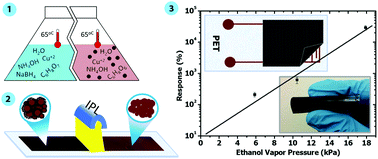Seed mediated copper nanoparticle synthesis for fabricating oxidation free interdigitated electrodes using intense pulse light sintering for flexible printed chemical sensors†
Abstract
A facile aqueous-based seed-mediated chemical reduction method is developed for the synthesis of copper nanoparticles. The nanoparticles are utilized to fabricate a flexible chemical sensor. The seed particles are spherical in shape with a mean diameter of 4.5 nm. Seed mediated growth is carried-out on the seed particles using L-ascorbic acid as a reducing and a capping agent in an aqueous solution. The seed mediated growth yields pure copper nanoparticles with a bimodal size distribution with mean diameters of 3.6 and 64.6 nm. The structural characterization, using X-ray diffraction (XRD) and UV-Visible spectroscopy (UV-Vis), reveals that the synthesized particles are oxidation free and exhibit a monotonic surface plasmon resonance (SPR) peak at 572 nm. The formulated nanoparticulate ink is printed on a flexible polyethylene terephthalate (PET) substrate and sintered with an intense pulse light (IPL) technique under ambient conditions resulting in an oxidation-free copper film within a milli-second time scale. The sheet resistance of the sintered film reaches 0.16 Ω □−1 yielding a film resistivity of 9.6 × 10−5 Ω cm. The as-synthesized particles are further employed to print interdigitated electrode patterns on a PET substrate using a syringe dispensing system. A chemical sensor is fabricated on the interdigitated electrodes using a novel graphite and polyethylene glycol (PEG) composite film. The chemical sensor exhibits an excellent response with up to 300 times change in the initial resistance when exposed to different concentrations of ethanol vapors, which demonstrates the potential of utilizing the copper nanoparticles developed in this study for flexible printed electronics applications.



 Please wait while we load your content...
Please wait while we load your content...